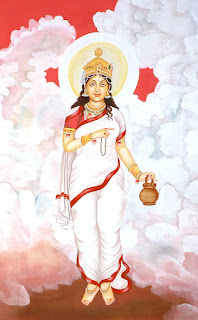Hanuman was born to Anjana, a female vanar, and Kesari, a male vanara, in ANJANA GIRI MOUNTAIN,one of the mountain along other mountain on the way to TIRUPATI. His mother was an apsara who was born on Earth as a female vanara due to a curse. She would be redeemed from this curse on her giving birth to an incarnation of Lord Shiva, who is also known as Rudra, and endowed with the Supreme Power of exalted devotion to Bhagwan Hari. Hanuman is endowed with 28 transcendental divine opulences, with perfection in each.
Multiple places in India are claimed as the birth place of Hanuman. Even Trimbakeshwar,Anjan, a small village about 18 km away from Gumla, houses "Anjan Dham", which is said to be the birth place of Hanuman.The name of the village is derived from the name of the goddess Anjani, mother of Mahaveer Hanuman. Aanjani Gufa (cave), 4 km from the village, is believed to be the place where Anjani once lived. Many objects of archaeological importance obtained from this site are now held at the Patna Museum. Its a popular belief that Hanuman was born on 'Anjaneya Hill', in Hampi, Karnataka. This is located near the Risyamukha mountain on the banks of the Pampa, where Sugreeva and Sri Rama are said to have met in Valmiki Ramayana's Kishkinda Kanda. There is a temple that marks the spot. Anjaneri (or Anjneri) mountain, located 7 km from Trimbakeshwar in the Nashik district, is also claimed as the birthplace of Hanuman.
Anjana, along with her husband Kesari, performed intense prayers to Lord Shiva to beget Him as her Child. Pleased with their devotion, Shiva granted them the boon they sought. Hence, Hanuman is also known as "Maharudra" because he was born of the boon given to Anjana by Shiva. The Valmiki Ramayana states that Kesari is the son of Brihaspati and that Kesari also fought on Rama's side in the war against Ravana.
Several different traditions account for Hanuman's birth. One is that at the time that Anjana was worshipping Lord Shiva, elsewhere, Dasharatha, the king of Ayodhya, was performing the Putrakama Yagna in order to have children. As a result, he received some sacred pudding, payasam, to be shared by his three wives, leading to the births of Rama, Lakshmana, Bharata, and Shatrughna. By divine ordinance, a kite snatched a fragment of that pudding and dropped it while flying over the forest where Anjana was engaged in worship. Vayu, the Hindu deity of the wind, delivered the falling pudding to the outstretched hands of Anjana, who consumed it. Hanuman was born to her as a result.
Hanuman, in one interpretation, is the incarnation or reflection of Shiva. Other interpretations, such as that of Dvaita, consider Hanuman to be the son of, or a manifestation of, Vayu, god of wind. When Ravana tried to enter the abode of Shiva, he called Nandishwara "a monkey". Nandishwara in turn cursed Ravana, that a monkey would burn his Lanka.
Another story of Hanuman's origins is derived from the Vishnu Purana and Naradeya Purana. Narada, infatuated with a princess, went to his God Lord Vishnu, to make him look like Sri Vishnu, so that the princess would garland him at Swayamvara. He asked for a Hari-Mukh. Hari is the name of Lord Vishnu and Mukh means face. But Vishnu instead bestowed him with the face of a monkey. Unaware of this, Narada went to the princess, who burst into laughter at the sight of his monkey face before all the king's court. Narada, unable to bear the humiliation, cursed Vishnu, that Vishnu would one day be dependent upon a vanara. Vishnu replied that what he had done was for Narada's own good, as he would have undermined his own powers if he were to enter matrimony. Vishnu also noted that Narada's request for Hari has the dual Sanskrit meaning of vanara. Upon hearing this, Narada repented for cursing his idol. But Vishnu told him not repent as the curse would act as a boon, for it would lead to the birth of Hanuman, without whose help Rama (Vishnu's avatar) could not kill Ravana.
References to Hanuman in classical literature could be found as early as those of 5th to 1st century BC in Panini's Astadhyayi, Abhiseka Nataka, Pratima Nataka, and Kalidas .
Share:














